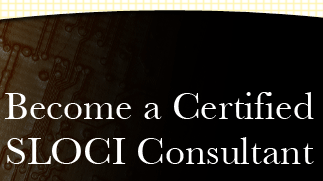 |
 |
Overview of the SLOCI© Certification Program: |
 |
 |
The SLOCI Certification Program is a 2 day, highly interactive learning seminar (similar to some executive education modules). Through expert facilitation, you will develop a deep understanding of organizational culture and how you can effectively utilize the SLOCI© in your various types of consulting or internal organizational initiatives. |
 |
|
 |
Upon completion of the seminar, you will become a certified SLOCI© consultant (CSC), which entitles you to survey organizations and generate SLOCI© reports for use in your consulting practice, or your own organization, as well as a myriad of other CSC benefits |
|
 |
|
Portions and Highlights of the SLOCI© Certification Program Include: |
|
|
Discussion on Understanding Organizational Culture: History, Misconceptions, Assumptions & Fact |
|
|
 |
What is organizational culture and why is it important? |
|
|
 |
The history of organizational culture research and differing viewpoints. |
|
|
 |
Common misconceptions around organizational culture, separating myth from fact. |
|
|
 |
How organizational culture influences a firm's performance. |
|
|
 |
The impact of organizational culture on M&A's and cross-divisional collaborations. |
|
|
 |
The key components of organizational culture above and below the iceberg. |
|
|
Discussion on Understanding the Schweiger-Larkey Organizational Culture Index |
|
|
 |
The research methodologies and statistics on which the SLOCI© is based. |
|
|
 |
Interpreting and understanding the SLOCI© standard reports and differences reports. |
|
|
 |
The 15 dimensions of the SLOCI© and how they impact organizational culture.< |
|
|
 |
Why and how the SLOCI© is different from other organizational culture assessments. |
|
|
 |
Hands on use of the SLOCI© and administration techniques. |
|
|
Interactive, Facilitated Session Using Case Study Examples for Understanding How to Effectively Use the SLOCI© for: |
|
|
 |
Leading and executing cultural transformation initiatives. |
|
|
 |
Executing cultural realignments when entering new markets. |
|
|
 |
Assessing potential targets and facilitating the integration of acquired companies. |
|
|
 |
Facilitating integration and managing culture clash in a merger. |
|
|
 |
Facilitating inter-organization cross-divisional and cross-border collaborations. |
|




